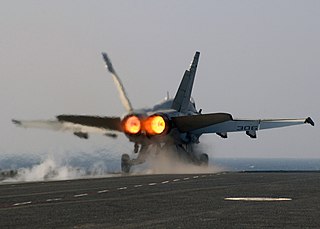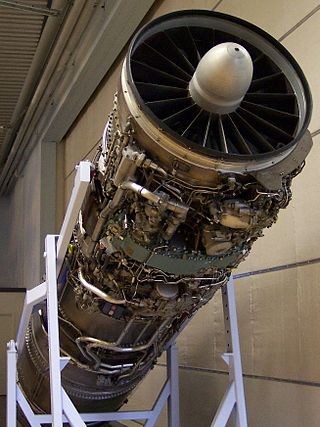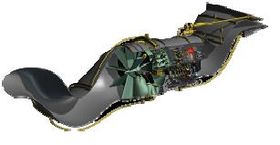
A jet engine is a type of reaction engine, discharging a fast-moving jet of heated gas that generates thrust by jet propulsion. While this broad definition may include rocket, water jet, and hybrid propulsion, the term jet engine typically refers to an internal combustion air-breathing jet engine such as a turbojet, turbofan, ramjet, pulse jet, or scramjet. In general, jet engines are internal combustion engines.

A ramjet is a form of airbreathing jet engine that requires forward motion of the engine to provide air for combustion. Ramjets work most efficiently at supersonic speeds around Mach 3 and can operate up to Mach 6.

A turboprop is a turbine engine that drives an aircraft propeller.

A turbofan or fanjet is a type of airbreathing jet engine that is widely used in aircraft propulsion. The word "turbofan" is a combination of the preceding generation engine technology of the turbojet, and a reference to the additional fan stage added. It consists of a gas turbine engine which achieves mechanical energy from combustion, and a ducted fan that uses the mechanical energy from the gas turbine to force air rearwards. Thus, whereas all the air taken in by a turbojet passes through the combustion chamber and turbines, in a turbofan some of that air bypasses these components. A turbofan thus can be thought of as a turbojet being used to drive a ducted fan, with both of these contributing to the thrust.

The turbojet is an airbreathing jet engine which is typically used in aircraft. It consists of a gas turbine with a propelling nozzle. The gas turbine has an air inlet which includes inlet guide vanes, a compressor, a combustion chamber, and a turbine. The compressed air from the compressor is heated by burning fuel in the combustion chamber and then allowed to expand through the turbine. The turbine exhaust is then expanded in the propelling nozzle where it is accelerated to high speed to provide thrust. Two engineers, Frank Whittle in the United Kingdom and Hans von Ohain in Germany, developed the concept independently into practical engines during the late 1930s.

An afterburner is an additional combustion component used on some jet engines, mostly those on military supersonic aircraft. Its purpose is to increase thrust, usually for supersonic flight, takeoff, and combat. The afterburning process injects additional fuel into a combustor in the jet pipe behind the turbine, "reheating" the exhaust gas. Afterburning significantly increases thrust as an alternative to using a bigger engine with its attendant weight penalty, but at the cost of increased fuel consumption which limits its use to short periods. This aircraft application of "reheat" contrasts with the meaning and implementation of "reheat" applicable to gas turbines driving electrical generators and which reduces fuel consumption.

The bypass ratio (BPR) of a turbofan engine is the ratio between the mass flow rate of the bypass stream to the mass flow rate entering the core. A 10:1 bypass ratio, for example, means that 10 kg of air passes through the bypass duct for every 1 kg of air passing through the core.

The Rolls-Royce RB.80 Conway was the first turbofan jet engine to enter service. Development started at Rolls-Royce in the 1940s, but the design was used only briefly, in the late 1950s and early 1960s, before other turbofan designs replaced it. The Conway engine was used on versions of the Handley Page Victor, Vickers VC10, Boeing 707-420 and Douglas DC-8-40.

The Pratt & Whitney J58 is an American jet engine that powered the Lockheed A-12, and subsequently the YF-12 and the SR-71 aircraft. It was an afterburning turbojet engine with a unique compressor bleed to the afterburner that gave increased thrust at high speeds. Because of the wide speed range of the aircraft, the engine needed two modes of operation to take it from stationary on the ground to 2,000 mph (3,200 km/h) at altitude. It was a conventional afterburning turbojet for take-off and acceleration to Mach 2 and then used permanent compressor bleed to the afterburner above Mach 2. The way the engine worked at cruise led it to be described as "acting like a turboramjet". It has also been described as a turboramjet based on incorrect statements describing the turbomachinery as being completely bypassed.
A propelling nozzle is a nozzle that converts the internal energy of a working gas into propulsive force; it is the nozzle, which forms a jet, that separates a gas turbine, or gas generator, from a jet engine.
A jet engine performs by converting fuel into thrust. How well it performs is an indication of what proportion of its fuel goes to waste. It transfers heat from burning fuel to air passing through the engine. In doing so it produces thrust work when propelling a vehicle but a lot of the fuel is wasted and only appears as heat. Propulsion engineers aim to minimize the degradation of fuel energy into unusable thermal energy. Increased emphasis on performance improvements for commercial airliners came in the 1970s from the rising cost of fuel.
Specific thrust is the thrust per unit air mass flowrate of a jet engine and can be calculated by the ratio of net thrust/total intake airflow.

The Rolls-Royce/Snecma Olympus 593 was an Anglo-French turbojet with reheat, which powered the supersonic airliner Concorde. It was initially a joint project between Bristol Siddeley Engines Limited (BSEL) and Snecma, derived from the Bristol Siddeley Olympus 22R engine. Rolls-Royce Limited acquired BSEL in 1966 during development of the engine, making BSEL the Bristol Engine Division of Rolls-Royce.

This article briefly describes the components and systems found in jet engines.

The Volvo RM8 is a low-bypass afterburning turbofan jet engine developed for the Saab 37 Viggen fighter. An augmented bypass engine was required to give both better fuel consumption at cruise speeds and higher thrust boosting for its short take-off requirement than would be possible using a turbojet. In 1962, the civil Pratt & Whitney JT8D engine, as used for airliners such as the Boeing 727, was chosen as the only engine available which could be modified to meet the Viggen requirements. The RM8 was a licensed-built version of the JT8D, but extensively modified for supersonic speeds, with a Swedish-designed afterburner, and was produced by Svenska Flygmotor.
An airbreathing jet engine is a jet engine in which the exhaust gas which supplies jet propulsion is atmospheric air, which is taken in, compressed, heated, and expanded back to atmospheric pressure through a propelling nozzle. Compression may be provided by a gas turbine, as in the original turbojet and newer turbofan, or arise solely from the ram pressure of the vehicle's velocity, as with the ramjet and pulsejet.
The Packard XJ49 was the first U.S. designed turbofan aircraft engine, and was developed by the Packard Motor Co. in the 1940s.
The Daimler-Benz DB 007 was an early German jet engine design stemming from design work carried out by Karl Leist from 1939. This was a complex design featuring contra-rotating stages and a bypass fan, making it one of the earliest turbofan designs to be produced. The end result of the design work was built as the DB 007 and began testing on a test-bed on 27 May 1943. Due to the expected low performance, complexity and the good results achieved by much simpler designs, work was halted on the DB 007 in May 1944 by order of the RLM.
The familiar study of jet aircraft treats jet thrust with a "black box" description which only looks at what goes into the jet engine, air and fuel, and what comes out, exhaust gas and an unbalanced force. This force, called thrust, is the sum of the momentum difference between entry and exit and any unbalanced pressure force between entry and exit, as explained in "Thrust calculation".

The General Electric Affinity was a turbofan developed by GE Aviation for supersonic transports. Conceived in May 2017 to power the Aerion AS2 supersonic business jet, initial design was completed in 2018 and detailed design in 2020 for the first prototype production. GE Aviation discontinued development of the engine in May 2021. Its high-pressure core is derived from the CFM56, matched to a new twin fan low-pressure section for a reduced bypass ratio better suited to supersonic flight.


















